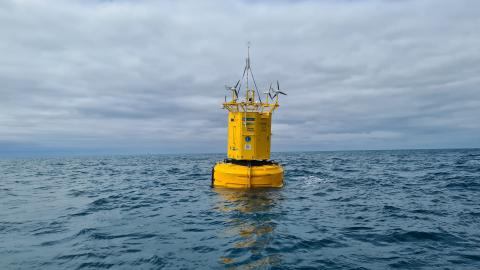
Atmospheric carbon dioxide (CO2) exceeded 420 ppm in 2024 and has continued to increase by approximately 2.5 ppm per year over the last decade. The global ocean absorbs approximately a quarter of anthropogenic CO2 emissions annually.
The North Atlantic Ocean contains more anthropogenic CO2 than any other ocean basin, and surface waters are experiencing an ongoing decline in pH (increasing acidity). Rates of acidification in bottom waters are occurring faster at some locations than in surface waters.
Some species are already showing effects from ocean acidification when exposed to short-term fluctuations and could be used as indicator species for long-term impacts on marine ecosystems.
High evidence, high consensus
The overall confidence is stated as high, but it should be noted this relates to the fundamental chemistry underlying air–sea carbon dioxide exchange and the ocean pH decline from anthropogenic carbon dioxide uptake, which are both well established. In open oceans, the change in chemistry is observable, having been investigated by a multitude of independent techniques (observations, modelling and reanalysis assessments) with concordant results (medium evidence, high agreement). There are still significant knowledge gaps for shelf sea carbonate chemistry, including many of the factors affecting local and short-term variability relevant to ecosystem services. Models do not generally capture the short-term and local variability of the carbonate system, which is where much of the interest is in terms of ecosystem services for humans living in the coastal zone.
- Models project that the average continental shelf seawater pH will continue to decline to year 2050 at similar rates to the present day, with rates then increasing in the second half of the century, depending on the emissions scenario.
- The rate of pH decline in coastal areas is projected to be faster in some areas (e.g. Bristol Channel) than others, such as the Celtic Sea.
- Under high-emission scenarios, it is projected that bottom waters on the North-West European Shelf seas will become corrosive to more-soluble forms of calcium carbonate (aragonite). Episodic undersaturation events are projected to begin by 2030.
- By 2100, up to 90% of the north-west European shelf seas may experience undersaturation for at least one month of each year.
- High levels of nearshore variability in carbonate chemistry may mean that some coastal species have a higher adaptative capacity than others. However, all species are at increased risk from extreme exposure episodes.
Medium (medium evidence, medium agreement)
As for ‘what is already happening’, it is not easy to give a single confidence value to ‘what could happen in the future’ and there are additional inherent uncertainties relating to societal behaviour and emission pathways. There is very high confidence that global mean seawater pH and saturation states of carbonate minerals will continue to decrease in response to increasing atmospheric carbon dioxide. However, specific details of regionally resolved decadal trends and changes in interannual and seasonal variability are less certain, due to the complex interplay of multiple pressures. The high importance of relatively small-scale processes in near-coastal environments adds uncertainty to model results for these regions, although this is improving. These uncertainties, including which future scenario might prevail, and the lack of regional assessment under the lower RCP2.6 scenario, means the overall confidence level is at ‘medium’ for understanding of the future of ocean acidification and its impacts in UK Shelf seas.
1. Lack of data prevents good understanding of near-shore dynamics and trends as well as being able to relate physicochemical changes to biological change. There is a need to:
- Increase near-shore and shallow coastal environments monitoring activities at higher spatial and temporal resolution compared with the open ocean to understand drivers and biological responses.
- Sustain long-term time–series observations of the marine carbonate system at key point sites and transects with biological monitoring to ascertain the scale and magnitude of observed changes (observations for surface CO2 currently appear to be in decline).
- Increase coupling of physicochemical and biological monitoring to support ecosystem risk assessments and better inform planning and management strategies.
- Develop accurate and stable autonomous observing technologies for pH and related variables, deploying in difficult-to-sample regions, and linking and analysing their measurements effectively with other data streams.
2. Ocean acidification effects will not act in isolation; future ocean acidification studies need to be conducted in relation to other stressors (e.g. temperature, oxygen, metals, etc.). This requires:
- Local ecosystem and societally relevant experimental work together with an ability to assess changes in multiple parameters in the field.
- Improved spatial and temporal resolution of models, along with their descriptions of biogeochemical processes, to capture the relatively small-scale controls on the marine carbonate system in complex coastal and shelf sea environments.
3. Uncertainty of model-derived products need to be assessed and, where possible, reduced, including through:
- Standardise procedures to include impacts of large-scale ocean acidification in regional models.
- Move from single simulations to ensemble of simulations, both for the recent past, but especially for future projections where the drivers of uncertainty increase due to multiple scenarios and multiple climate models with different climate sensitivities.
4. Data is not always readily available or compatible to bring together for holistic large-scale assessments of trends and impacts from ocean acidification. Capacity building is needed, including:
- Co-ordinating intercomparison and intra-calibration activities, and development of quality control schemes to increase training and proficiency in carbonate chemistry and biological monitoring across UK laboratories.
- Continued support for a centralised Data Hub to catalogue time–series records and store metadata across UK sites, with data standards that enable harvesting and sharing between data archiving centres and data product generators.
Image credit: Plymouth Marine Laboratory